Mehul Jangir's Blog
September 7, 2022
SECMOL, Ladakh//9.22
 The view out of my room’s window
The view out of my room’s window The view during the flight to Let
The view during the flight to Let Terra Hall, SECMOL Campus
Terra Hall, SECMOL Campus SECMOL Mountain in the evening
SECMOL Mountain in the evening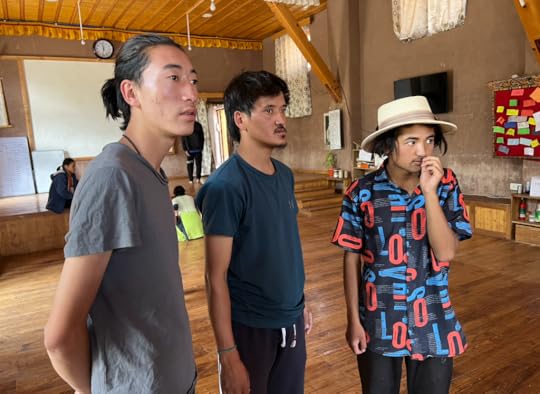 Friends at SECMOL Campus
Friends at SECMOL Campus  An amazing Teacher’s Day celebration
An amazing Teacher’s Day celebration The Drive to Lamayuru Monastery
The Drive to Lamayuru Monastery  Art at Lamayuru Monastery
Art at Lamayuru Monastery The post SECMOL, Ladakh//9.22 appeared first on Blog | Mehul Jangir.
August 30, 2022
Project Hail Mary//Andy Weir
Have you ever read a book you couldn’t put down? Project Hail Mary is, bluntly, absorbing. Andy Weir tells a story about sacrifice and discovery through the eyes of a spacefaring protagonist. The catch? You only know as much as the protagonist’s severe amnesia allows.
SPOILER//WARNING
The endgame is simple: save humanity from cellular alien life in outer space that’s feeding on the Sun’s energy output, Astrophage. The more they consume, the larger their population. And the larger their population, the colder Earth gets. As Grace solves this science-fiction mystery, regular flashbacks help him regain his memory.
This straightforward plot is interrupted by two jarring twists: the realisation that he isn’t in the Solar System and the arrival of another species capable of interstellar travel.
Weir focuses on how different alien life can be. The Eridians are rocky, metallic, five-legged spiders with a photographic memory. They see with sound, and live in a highly pressurised, ammonia-rich environment. They inhabit a Super-Earth with a brick wall of a magnetic field. The Eridians are explorers and engineers, but not scientists – they only learn about relativity and interstellar radiation from Grace.
Project Hail Mary is emotionally captivating. You feel the loneliness of orbiting a distant sun all alone. You feel the shock of finding an alien spaceship, the relief of companionship, and the nostalgia following a goodbye.
Some of the book delves deeper into fiction than science. Take the amount of power Stratt has, or the artificial labels put on the people Grace knows. Stratt? Authoritative. Chinese astronaut? Strict. Russian cosmonaut? Energetic Vodka-lover. To save humanity, Earth’s band of heroes commit outlandish acts: paving the Sahara with solar panels, or detonating nuclear bombs in Antarctica.
But, Project Hail Mary is bold. It navigates past the deluges of technical information in Weir’s previous novels. Weir’s latest work is persistent in being captivating, and dazzling in its presentation of ideas that challenge the science-fiction status-quo.
The post Project Hail Mary//Andy Weir appeared first on Blog | Mehul Jangir.
August 20, 2022
Pushkar 20.8.22
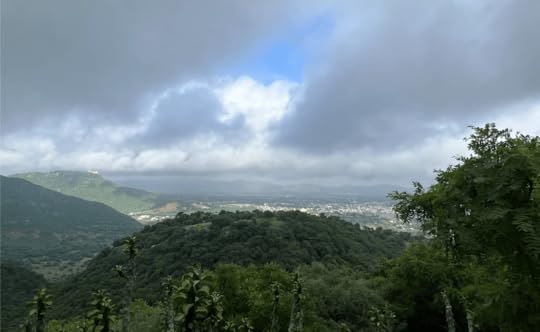 View from above a cave. Not many people know about this hike. You can see Pushkar off in the distance.
View from above a cave. Not many people know about this hike. You can see Pushkar off in the distance. My friends and I behind Savitri temple.
My friends and I behind Savitri temple.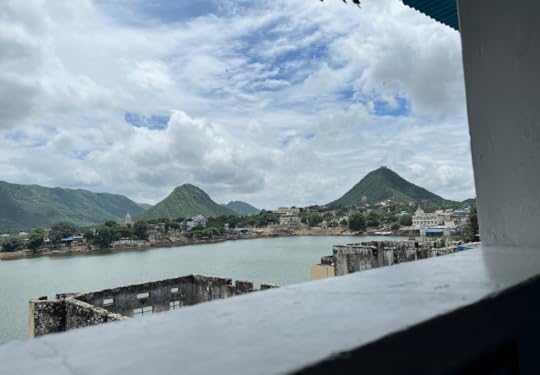 The view from Laura’s Cafe
The view from Laura’s Cafe  Sunlight illuminating the mountainside through the clouds at Savitri temple.
Sunlight illuminating the mountainside through the clouds at Savitri temple. 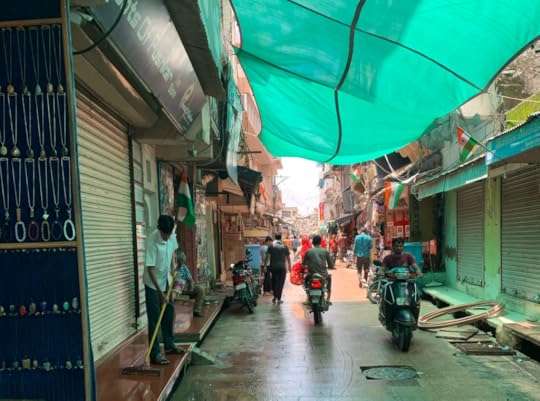 The streets of Pushkar
The streets of Pushkar Eklavya
Eklavya Some beautiful weather on the way to Pushkar
Some beautiful weather on the way to Pushkar  Another image of the view from Savitri temple.
Another image of the view from Savitri temple.The post Pushkar 20.8.22 appeared first on Blog | Mehul Jangir.
July 9, 2021
Summary of Reading – June ’21
Great worldbuilding. Clarke’s descriptions of alien life were definitely quite different. They were also much more realistic given the remote likelihood of alien life being humanoid. Life inside Jupiter was … pretty bizarre and thought-provoking. How would gas-based creatures live? How would their biological systems work? Of course, even the notion of there being biological systems in such creatures can be questioned.
Now, what really made 2001 so mesmerising were Bowman’s accounts of his journey. Simply put, what the monolith showed him was awe-inspiring. Clarke doesn’t recreate that same sense of awe. While the imagery of, say, seeing stars merging was delightful for audiences back then, it’s nothing but a quick google search now. 2010 really replaces this awe with danger. “Attempt no landings there,” a message as clear as day, broadcast by the aliens and a quote that really encapsulates how humankind sees the monoliths.
It was also quite telling to see just how advanced the civilisation that created the monoliths is. Firstly, using the most fundamental building materials to make more monoliths, and then turning a planet into a cosmic oven and creating a mini-star is a feat of engineering we humans can’t even dare to dream about.
The Ballad of Songbirds and Snakes (Suzanne Collins)‘Twas pretty exciting to be back in the Hunger Games universe and YA Dystopia after a long time. I headed into this book entirely spoiler-free, to the extent that I had to figure out who the characters were and when it was set independently as I read the book. Seeing the antagonist of the original trilogy presented as the protagonist here was quite fun and probably the only aspect of the book I found enjoyable.
I found a lot of things quite stupid. Firstly, the fallout between Lucy and Snow just seemed extremely artificial. How do two people who are very much in love go from running away together to attempting to murder each other in literal seconds. Throughout the book, I found Snow’s liking for Lucy as something that made him see the Capitol from the perspective of the districts, but all of that just went away in a single scene. Tons of character development wasted here. I didn’t understand Snow’s inbuilt dislike for bird-song, and that too after how he adored Lucy’s songs. Just didn’t make sense.
In all, this book felt like both a much-needed deeper foray into the hunger games world but also quite forced. Throughout the book, it seemed as if Snow would understand how the districts felt, but he just inexplicably veered off that course in an instant. It was interesting seeing things from his perspective. However, elements like Sejanus’s actions, his tie with Lucy Gray, how he didn’t exactly like the Hunger Games and his time as a peacekeeper are elements that don’t fit in well with him being a tyrannical ruler.
And Then There Were None (Agatha Christie)A brilliant murder-suspense storyline. I enjoyed reading this book, and it gave off a very read-in-a-single-go vibe which was nice. The main element that serves to engage is the reader themselves trying to figure out who is doing what. This is something all detective novels do but this one accomplished to great detail. I couldn’t really tell who the murderer was until the confession at the end, and the suspense overshadowed the annoyance at being in the dark for so long.
The Girl on the Train (Paula Hawkins)I’ve been holding reading this book off for a bit inexplicably. Hawkins throws a lot of light on how certain mental health issues affect people, and I’m all for it.
I genuinely did see Tom as the victim throughout a majority of the book. It felt like he was receiving a lot of negative attention from Rachel. In fact, the notion that Rachel is at fault is what I thought would be the result. I believed that the author would build up to Rachel’s repressed memories being her attacking Megan due to her resemblance to Anna out of spite. The clues were there: blood on her clothes, signs of physical trauma indicating a fight etc.
At the same time, I never really fell for the therapist-did-it idea. Kamal did engage in wrongdoing through a relationship with a patient, but his moral compass shone through in each of their interactions. If someone can question a relationship repeatedly, and put a complete stop to it due to nothing but guilt, how can he be the one who murdered the patient?
The husband never felt guilty because of his interactions with Rachel and how Hawkins conveyed his emotions.
At the end of the day, it’s pretty telling how people can be so incredibly manipulative. Tom’s exploitation of Rachel’s blacked out episodes was also quite astounding. More than anything else, I really admire how Hawkins portrayed Rachel as someone who is still. While Tom and Anna are raising their baby and Megan is working on herself through therapy, Rachel is at a complete standstill mentally. She’s reliving the same day again and again. Looking out the same window. Passing out drunk the same way to avoid her sorrows. An incredibly good picture of how depression can be.
2061: Odyssey Three (Arthur Clarke)This book seemed to go slowly as compared to the previous two books in the series. In fact, I find the decline of quality in Ender’s Saga similar to the decline in action in the Odyssey series.
The “wow” moments of previous books – Bowman’s journey in 2001 and the discovery of life on Europa in 2010 weren’t replicated at all. I mean, there was the awe in finding a mountain that was a single, pristine diamond, but it never really matched the feeling of exhilaration generated in the previous books.
The post Summary of Reading – June ’21 appeared first on Blog | Mehul Jangir.
September 2, 2020
Personality Blender.
I remember sitting in the new building’s relatively large auditorium on my first day of freshman year four years ago. Starry-eyed and intoxicated with the transition from middle school (years of fun and frolic) to the four years of high school that were apparently meant to be the bridge to the rest of your life, I was both scared and excited. I remember being the only student who opted for 11 subjects in grade 9, which invited the nickname “Mr Genius.” More than that, I remember having no clue where I would end up at the end of high school. I didn’t even know about the very existence of any university other than Stanford and Harvard.
I’ve spent the 2102400 minutes between the present and that first day working not for some extrinsic goal, but for myself. I’ve never seen the college admissions mania as something that requires you to mould yourself to wherever you’re applying, or mould yourself to the general applicant pool, or try and resemble that one Russian kid who interned at Google, won the International Math Olympiad, and got his start-up acquired by a Fortune 500 company. On the contrary, rather than fitting myself to a college, I’ve always wanted to fit a college to me, and that’s imparted in me a variety of passions, hobbies, and goals for the future.
Looking back, there’s so much I’ve done and so much that has happened that I would’ve never imagined. It seems only yesterday that I received my first full chemistry grade, played football with my friends, fell just short of my personal goal for my IGCSEs, and took my first step in a whole new world. During this insanely long time period, I never once thought about looking back and seeing how far I’ve come. I can’t imagine going back and telling 9th grade Mehul that he would be here right now.
No matter which college I go to and where I’m accepted, I’m satisfied with the knowledge that I didn’t do what I had to or what was instructed to, but I did what I wanted to, and that should be enough to set me apart from anyone else out there. I’ve taken away something memorable from each experience, from each day, whether be it an academic trait I previously undervalued or a character flaw I worked to correct.
Over the course of the next few months, I’ll be applying to some of the best and definitely the most enriching universities in the world. It excites me and it scares me. I’m afraid of the countless possibilities the future holds, of that lingering doubt that I might not get into this place. At the same time, I’m proud of what I’ve done and excited to continue doing that. Over the past few years I’ve gone from having no clue what to do, to developing visible interests in engineering, computer science, and astrophysics.
While computer science and engineering are domains I feel naturally attracted to, the former being a field wherein I’ve interned, hacked, and programmed, nothing invokes as much awe as astrophysics. This leaves me with a huge decision to make before I apply, what do I want to do at college? Do I want to write code and study algorithms? Do I want to make robots and machines? Do I want to point my eyes into the deepest depths of the cosmos and maybe try exploring it? The answer is, irrefutably and undeniably, is all of them. I’ve never been a person who does just one thing. It’s why I took 11 subjects in grade 9, I can’t stand not doing enough. Even right now, despite being told about the intensive and demanding and 24×7 nature of the college applications process, I want to continue exploring and learning in other domains.
I feel like the world has made it necessary for you to be one person. You’re either an engineer or a computer scientist, there’s no ‘both here. There’s no way to do stuff simultaneously. This leaves me with having to choose between what I feel like is me. It’s like asking me to throw away one interest, neglect another, and choose one as the thing that will define my life.
This is all the more important because both cricket and writing were prominent items on this list of ‘who I am.’ Ask ninth grade me what I wanted to become, and he would probably say “either an astrophysicist, or a player in the Indian cricket team, or an author, or a programmer.” While my list of items that define me may change, the mere fact that I have a list cannot. This certainly makes me question myself, should I let this unidirectional-ness change me? Or should I try and change it on my own personal level?
When talking about the college applications process, everyone says that it is inherently transformative. That while working on your applications and taking a deeper look at yourself than any university will do when putting you up against 50k other applications, you learn who you are and you know what you want to do. I find this notion to be quite absurd, I don’t see any point to applying somewhere if you don’t even know who you are per say. I know I want to go into computer science, mechanical engineering, and astrophysics, all 3 of these collectively. There may be no option to do so, but that’s what I want, and that’s what defines me.
This all connects back to me always doing what I’ve wanted to. You may look at my resume and break it down into a person who has a passion for STEM or a guy with a flair for writing, all of that comes together: my passion for programming, my ardor for engineering, my curiosity in understanding the universe, and my love for writing to make what is irrefutably a personality blend that is, me.
The post Personality Blender. appeared first on Blog | Mehul Jangir.
September 1, 2020
Summary of Reading – August ’20
Astronomy (Andrew Fraknoi et al.) – A bit too heavy at times, and way too much extra material that is exciting but definitely can’t be done in a single day or such. Got some really nice visuals and challenging quantitative problems, definitely would recommend as a free astronomy textbook available on the internet.
The Amazing Adventures of Kavalier and Clay – I took an extraordinarily long amount of time to finish reading this book, and it is definitely one of the longest books I’ve ever read. Sammy’s arc, which started when he realised his own nature and started accepting it albeit secretly to coming to odds with the fact that everyone knew about it and living with no secrets was totally brilliant. Both Sammy and Joe started out with clear hurdles and goals. Sammy with his gender and Joe with his family. While I did find the book to be quite stretched at times, the insane amount of characterisation and growth that went into everything was quite astounding. One thing that did stand out was how Rosa waited twelve+ years for Joe to come back, which ordinarily isn’t something someone would’ve done. I think the entire committee on the investigation of comic books was portrayed to be quite antagonistic, and it was, and to me, that stood as symbolic of how systems larger than any individual tend to ignore individual motivations and escape the truth when an alternate explanation is equally plausible
The post Summary of Reading – August ’20 appeared first on Blog | Mehul Jangir.
August 16, 2020
Taking a look at UV-flash accompanied Type Ia Supernovae
This post is a report/summary/discussion on a research paper published by Northwestern University, and a research article published by science daily on the paper in question.
Spectacular ultraviolet flash may finally explain how white dwarfs explode
Date: July 23rd 2020
Source: Northwestern University
White dwarfs are stars that have burnt up all of the hydrogen they once used as fuel. The inward push of gravity is balanced by electron degeneracy pressure. Fusion in a white dwarf’s core produces outwards pressure, which is balanced by the inward push of gravity due to the star’s mass. A type Ia supernova occurs when a white dwarf in a binary star system goes over the Chandrashekhar limit due to accreting mass from or a merger with its companion star. Ultraviolet radiation is produced by high temperature surfaces in space, such as the surfaces of blue supergiants.
The research article details an astronomical event wherein a type Ia supernova explosion, a relatively common phenomenon, is accompanied by a UV flash, an incredibly rare phenomenon. This is pointed out as the second observed occurrence of such an event, making it innately important and intriguing. The supernova was first observed in December, 2019, using the Zwicky Transient-Facility in California. The event was dubbed as SN2019yvq, and it occurred in a nearby galaxy that lies 140 million light years from planet Earth in the Draco constellation.
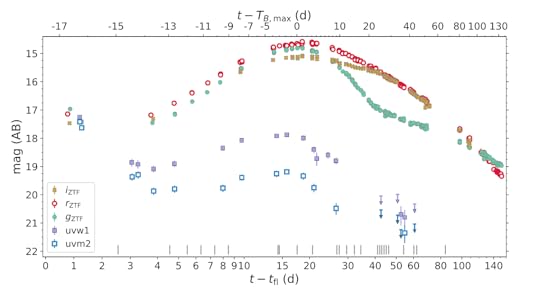
The given figure is a light curve for the observed type Ia supernova. A light curve plots the brightness of an object against time, as to showcase how its brightness/magnitude varies with time. This technique is used in other domains and applications like transit photometry. This light curve plots the absolute magnitude of 2019yvq, the event this paper looks at. The light curve of a supernova usually reaches a peak quickly, then gradually “cools off” with lowering intensity and brightness. This is demonstrated above.
What set this particular type Ia supernova apart was the aforementioned UV flash. What makes a UV flash important in this event is that it indicates very hot material in the white dwarf. This is presumably because of the explosion heating the material which was responsible for emitting light. The study offers four potential explanations behind the event: a consumed companion star that became so large that is exploded, leading to a UV flash; radioactive core materials reacting with the outer layer to make it very hot; an outer layer of helium igniting a carbon core; and two white dwarfs colliding and exploding. Understanding how type Ia supernovae work is key to our understanding of planetary formation as they produce iron, the most abundant element in the core of planets like the Earth. More importantly, type Ia supernovae can be used as ‘standard candles’ to measure extremely large cosmic distances. White dwarfs explode with the same brightness; hence their distance from planet Earth is inversely proportional to how brightly they seem to explode as observed from the Earth.. Further dividing type Ia supernovae on the basis of UV flashes would make the use of these cosmic yardsticks more accurate. Determining distances more accurately extends to working towards bigger challenges like how can we model the universe’s expansion accurately, what is dark energy, and how much of ‘stuff’ is dark energy.
The implications of classifying type Ia supernovae further would lead to improved cosmic distance measurements, enabling insights into the nature of cosmic inflation and dark energy. Furthemore, the very act of attempting to classify type Ia supernovae with UV flashes could lead to the discovery of an entirely new astronomical event, which could catalyse a sub-domain of astronomical study. They add a more reliable and robust method of distance measurement to a gallery of techniques: radio astronomy, stellar parallax, cepheid variables, the Tully-Fisher relation etc. What type Ia supernovae add to this ‘gallery’ is the ability to measure incredibly large cosmic distances due to how bright their explosions are in absolute terms. This phenomenon offers improved accuracy over incredibly large distances.
Another pressing question is determining whether or not type Ia supernovae with UV flashes constitute a threat to us, if say, one occurs in our galactic neighbourhood. After observing a greater number of such events, a ‘safe distance’ could be determined below which such a supernova would have a sterilizing impact on life on Earth. According to the paper, the flash is of 19th magnitude as observed from planet Earth. At a distance that is 10^6 times smaller, 140 light years, this would be 10^12 times brighter, or a magnitude of -11.
To conclude, discovering why these UV flashes occur and what they mean for cosmic distance measurement using type Ia supernovae can provide inroads into other pressing problems, like dark matter and dark energy.
The post Taking a look at UV-flash accompanied Type Ia Supernovae appeared first on Blog | Mehul Jangir.
July 31, 2020
Summary of Reading – July ’20
Speaker for the Dead (Orson Scott Card) – Very beautiful and elegant. The slow pace and the depth of understanding here, along with the level of detail and complexity works well with the pace, seriousness, and action of the first book in the series. It’s great to see Card take a respite from pure action and thrill and focus a lot on world-building, which sets up the sequel to this book pretty well. It’s amazing how similar the situation set up by the ending is to the plot of the first book, an invitation for xenocide.
I really like how the story progresses and how Card transitions the murders (apparent) of Pipo and Libo to something done for a very honourable and specific purpose. What seemed like a monstrous act was instead an event of transformation, of sending your best to the afterlife (which is very real for the piggies). It also enabled that evident and missed gap of communication that would be present between any two species, and that’s how Card made the human interpretation of Pipo’s and Libo’s deaths look horrific but then made the human interpretation itself look very biased. Personally, I thought Pipo was killed by stumbling onto one of the Piggies’ closely guarded secrets, one they would kill to protect, and that the same fate befell Libo, albeit independently. It wasn’t so, they both were killed for refusing to kill and send their brothers to their third lives (also note how important ‘third’ is now compared to what ‘third’ was at the start of the book).
Ender’s level of control and influence is also brilliant. How he uses his skills to unravel the situation almost perfectly, and guide everyone towards a rebellion is amazing. It’s beautiful character development. Over the course of two books, Ender goes from being a compassionate killer to a wonderful father and a man who has fully redeemed himself by bringing the species he destroyed back to life and nurturing a new species so as to prevent them from the same fate the buggers met.
It’s also quite interesting to read about the ecology on the planet. How every living thing shares a plant-animal life cycle. Raises a lot of questions about our basal assumptions for any form of alien life.
Xenocide (Orson Scott Card) – One of the best books I’ve read so far, and that’s saying a lot. While the scientific reasoning behind many things may not be sound (anything at all regarding philotes i.e), the book more than makes up for it through world-building, action, and plot. It brings so many concepts and worldviews and beliefs together that it is just exhilarating. The concept of genetic enslavement was rather interesting to read about. The people of Path were genetically enhanced to be more intelligent than any other human being, but had a specific gene engineering inside them that led them to believe in the power of the gods and that the gods spoke to them to keep them on their path, making them slaves to Congress. I like how the plant itself is named path, and how the tampered gene is an attempt to make everyone fall onto the designated path, but as the story ends, the planet goes on to forge its own path. We also see genetic enslavement in the form of the descolada. I find the entire concept to be dictatorial and bizarre, and also worrisome as it isn’t that hard for something like that to be done irl.
In terms of storytelling, Peter’s return might just breathe back the intense action and absorbance of the first book into the series. It was definitely a huge surprise. However, the brilliance of Peter’s return is equally matched by Novinha’s stupidity. I mean, what was Novinha even doing? Why did she become a nun? While the dependence of every single character on mysterious religious power is troubling, as any advanced future society should’ve freed itself of the shackles of religious belief by then, what’s even more disturbing is the big question: what happened to Jane? I take it she will be weakened, but what happens? The ending felt like a small calm before the storm, and I personally believe that this is great, as the next book heralds the arrival of the fleet, Peter’s bid to destroy Congress, and the end of Ender’s journey.
We are the Nerds (Christine Lagorio-Chafkin) – Not as good a read as I expected it to be, primarily because I use reddit a lot and I expected an account of its history to be based more on the product rather than the people running it or the social lives of the people running it. Before reading this book, I was expecting an account of reddit’s journey as a product, not as a business. Furthermore, the book goes off on various tangents, everything from Ohanion’s relationship with Serena Williams to Aaron Swartz and net neutrality. While I feel this may have been necessary to attract a larger audience (Aaron Swartz attracts tech-savvy people and Williams is just famous), it isn’t related to reddit whatsoever. However, there were some aspects of this book I found fascinating. One of these was Huffman’s return, which sounded quite poetic. I was surprised by how he wasn’t able to fit in and needed a counsellor/therapist. I also found the entire “spezgiving” saga to be quite childish, but it really brought out how big businessmen/women are the same people as us, and how they’re prone to the same mistakes. I also found it interesting to read about how people are targeted online and the internet’s potential to be downright toxic (seeing as I’ve encountered a very small portion of this toxicity myself), but how its countered by the internet’s ability to be wholesome, helpful, and amazing. The best example of this, in the book, was perhaps Barack Obama’s reddit AMA, or perhaps the “Mr Splashy Pants” thing. While there were some likeable facets to the book, it doesn’t really do justice to its title.
The post Summary of Reading – July ’20 appeared first on Blog | Mehul Jangir.
July 28, 2020
Modelling COVID-19 Cases for South Korea, India, and Sweden.
I recently wrote a paper that modelled the spread of covid-19 in Italy using a logistic fit. I wrote this a while back, and I was curious about how such a logistic function would behave NOW, so I decided to look at how a logistic fit could be applied to India, South Korea, and Sweden. I’ve taken these 3 countries because they’ve adopted entirely different approaches to tackling the pandemic, so I was curious as to whether or not the effects of these approaches would be graphically discernible. Here, I modelled the cumulative confirmed cases for the respective country against the number of days since the beginning of the outbreak. I’ll go through solely the results, you can find the full code here.
I’m using covid19api.com for obtaining the required data. It gives you a good deal of data, and has excellent support so I’d recommend using this API for all things covid-19. After obtaining the data, I treated it by filtering out undesired columns/rows, converting the date string to an integer that represented number of days since the beginning of the outbreak, and broke my data into a feature matrice and a target vector. I’ve used a logistic function for fitting the data.
South Korea
Here are the results, graphically, for South Korea.
[image error]
It’s evident that the logistic model can’t correctly explain the epidemic in South Korea, but that’s because of the South Korean government’s perfect handling of their localised cluster. South Korea rolled out tests and implemented stringiest social distancing policies not just more effectively, but more quickly than any other country. The graph acts as representative of these results. Real world cases overtake the logistic fit, but then fall back down. South Korea’s strict implementation of social distancing and mass-scale testing can be seen to be effective at around the 50 day mark. The curve flattens out, to some extent, but then resumes an upwards slope.
India
India demonstrates a nearly perfect logistic fit. You can see that the logistic model explains really world data to what appears to be nearly perfect accuracy. I believe this is because of some inherent conditions here. Firstly, population density. It’s hard not to come in contact with someone else while sick in India. While modelling a disease’s spread, you use a r0 value. In other countries, population density may restrict how many people an infected person infects. However, In India, any individual who is not quarantined and sick will come in contact with more people than the R0 number.
[image error]
Sweden
A logistic model also seems to describe the situation in Sweden pretty well. The logistic fit largely pertains to real world data. This is somewhat of a surprise, as Sweden implemented a vastly different policy regarding COVID-19. Instead of carrying out mass scale testing or enforcing a lockdown, Sweden opted for ‘herd immunity.’ Herd immunity is immunity to a disease as a consequence of a large proportion of the population having recovered from it. On a social level, this didn’t exactly go well for Sweden.
[image error]
I think its quite interesting to look at how accurate logistic models are in states with different approaches. For instance, South Korea succeeded in pushing down the R0 in their cluster due to testing and quarantine. India, on the other hand, has so far failed to implement any successful policy that reduces the R0 values. Sweden is actually trying to increase its R0 so as to develop herd immunity. One inherent assumption in any logistic model, and most epidemiological models is that the R0 value remains largely constant. This assumption definitely holds true for India and Sweden, but breaks down when it comes to South Korea.
The post Modelling COVID-19 Cases for South Korea, India, and Sweden. appeared first on Blog | Mehul Jangir.
June 29, 2020
Summary of Reading (June ’20)
Rafa (Rafael Nadal) – I’ve never really been that engrossed with tennis so reading this book was an insight into a world I’ve never really been a part of, but it was fun nonetheless. Major parts of the book seemed like they were devoted to more tennis-tuned readers, given that there’s a lot on game specifics and a lot of tennis terminology that went flying over my head. I found it really insightful to read about the impact his social and mental stability had on his physical stability and his game. I especially found the sections on the the importance of family to Nadal, and how his circle of stability helps him. It was also inspiring to read about having such a concrete routine that you’re at the court of 5 am no matter what and no matter how much sleep you were able to get. He talks a lot about having a very focused mental state during the game, and filtering everything out but the game so that you have very high concentration, and I relate to that not just because I’ve played cricket in the past, but because that state of mind where nothing else can impact you and all your mind is bent on particular task is something I try to attain and do attain while programming or reading. The sections on humility are also wonderful to read, but also mildly humorous sometimes, especially the parts where he talks about how his uncle and coach, Toni, makes him perform small, irrelevant gestures like not walking in the middle of the group and not violating dress codes etc. I also enjoyed reading about Mallorca and the societal setup there, the amount of peace Nadal gets is incredibly valuable given not many athletes can afford that in the modern world, and seeing him talk about how important a factor that is is brilliant and wholly justified. This book deviated from my usual sci-fi adventures, but I enjoyed it but found the sections on describing games for long periods of time a bit too much.
The Three Body Problem (Cixin Liu) – An incredible book that brings together two vastly different story-lines in a manner I am yet to see. The book starts out in mundane manner, throwing you straight into the action wherein the antagonist’s father dies, forming the motivation for an act we see quite a while later. Everything that occurs at the starts: the countdown, weird results from experiments, the universe flashing, seem to be pure sci-fi elements that the author eithers fails to or doesn’t explain. The beauty of this book lies in turning that around into something that is rational and believable. Even more so, it’s amazing to see the Three Body video game turn into something that exists in the real world. Of course, abandoning the question of how life even came to be on such a world, it’s fascinating to see alternate theories play out as to how the environment functions, and see hundreds of years of scientific progress occur in the span of a few pages. The different scenarios that play out: solar trygzys, triple sun days, chaotic eras and so on make this book incredibly fascinating. Add to that the depth to which all characters have been created; we have Wang who is oblivious to the grand scheme of things but a good man at his core, then we have Dang Shi who is oblivious to the big picture and not a man of science, but the guy who always solves the problem through his core set of principles, and lastly we have Ye, an almost psychopathic personality with a deep hatred for humankind, such that she’s effectively brought and end to it. Learning about the 3 body problem was an incredible experience for me. I also loved the author’s note about how most ideas that take off fall back to ground because of how the gravity of reality is too strong.
Delta-V (Daniel Suarez) – Very much new, and very relevant. While some of the things in the book were downright outlandish, how Suarez portrayed everything and how real he made the dangers of space travel seem to be made this book amazing to read. The candidate smelection process had a lot of time and space devoted to it, and it payed off with it being one of the best pre-climax sections I’ve personally read. In fact, I’d say some of the stuff in the entire candidate selection section was better than the rest of the book and the climax. It was really good at hooking me on. Some stuff that stood out during the candidate selection process: the high-co2 atmosphere puzzle solving event, the psychological test, and most importantly, how bonds were being formed. When the actual crew went up to hotel LEO to pursue other projects, I thought that the book was dying down, and I personally vouched for the chosen crew dying in their first attempt and the actual crew substituting for them, but what Saurez did was much better, although admittedly a bit rushed. I also couldn’t quite comprehend why a spaceship that had 14 billion dollars invested in it had a lot of software errors that made living unbearable and potentially fatal for the crew. I mean, come on, if you have 14 billion dollars, surely you can have a nice programming team as well who don’t mess their job up. The entire concept of mining was made so much better by the sample schematics attached by Saurez towards the end, they really payed off. The arrival of the Argo was also surprising, and Joyce’s downfall was also kind of expected but tragic nonetheless. The worst part of the book, in my opinion, was how the new investors treated the astroanuts. That seemed like pure fiction, rather than the rest of the book, which was genuinely believable and inspiring. This book also hammered into me the sort of challenges future astronauts can face, and the sacrifices they might have to make. It really drove the point home; space is hard.
Ender’s Game (Orson Scott Card) – Pretty good read. What really held me back was the sheer outlandishness of a boy of eleven years of age leading an entire army and being representative of the Earth’s military WHILE not even realizing he was doing this. I know its purely fictional, and the story is quite impressive, but the entire notion of such a young person doing all that is beyond me. Another thing I did not understand was why Mazer Rackham didn’t lead the armies. He told Ender that he wouldn’t be alive until the date of the future battle, when instead that same battle was Ender’s training. The simple explanation for this is that Ender is better than Mazer. That being said, no matter how good Ender is, why would the authorities choose a 11 year old boy with an incredible skill set over an experienced veteran and celebrated hero? That doesn’t make any sense to me. I love the elegance in how Ender is compassionate at heart and Peter is more hurtful, but how events reverse roles, making Ender seem hurtful and Peter seem compassionate. Throughout the book, Ender’s desire to not be like Peter holds him back and dominates him, whereas Peter’s desire to be more compassionate drives him to greater heights. It’s a stunning depiction of how events in the real world can pan out, and how roles can be reversed even when characters are not. In very cliche fashion, I’m going to say that the character I bonded the most with was the main character, Ender, but only because of his tendency to look at things the way they were and not the way they were conventionally taken to be. The best example of this is how each team thought of the battleroom as horizontally aligned, but Ender was the only one who viewed it as a place where you’re going down towards your enemy and not straight, and that changed a lot. His tendency to tackle the rules is also brought out by the match against two teams, where he sends a man through the gate rather than eliminating the two teams. The ending is a bit heartbreaking, especially when Ender realizes that he didn’t just obliterate the opposite side which had its own culture and legacy, but also sacrificed soldiers on his side without knowing so, and seeing how the guilt of this plays out is fascinating.
Recursion (Blake Crouch) – A book that takes science and throws it out the front door. The reasoning that time has no linearity, and that the past, the present, and the future exist as one just makes no sense. The simplest way to gauge time is drink tea; your cup of tea cools down gradually, that’s the progression of time. However, time isn’t a thing in this book. Instead, it’s a virtual construct made by our brains to make everything much more simple. And guess what this means, you can travel back and forth, but not in time, in your memories. Now, in normal conditions, this would be time travel, but since time apparently does not exist in this book, or is as traversable as a physical dimension, this is just memory travel. The part that struck me the most was how Helena and Barry were not able to figure out how to nullify everything after the original timeline in what was about 198 years, when Slade did that on his own in just a single timeline. Both of them thought about it so much that Barry, who was a police detective in the first timeline, became an astrophysicist/quantum physicist in the second and was trying to calculate the Schwarzschild radius of a memory (what?). Both of them didn’t think about returning to the previous timeline by activating a dead memory. It’s only logicial that if you can time travel, the only way to nullify your existing timeline is to go back and cut out the event that birthed your existing timeline. Instead, Barry and Helina decided to try and find a way to remove dead memories themselves rather than the events that created those dead memories, had they decided to try and pursue the latter in 198 years, they would’ve succeeded. I also don’t get why people need to be killed to be sent back into their own timeline, or why the U-shaped building building just appeared and caused mass FMS rather than it being there forever and people getting FMS when the cut-off date finally came.
Currently Reading
The Amazing Adventures of Kavalier and Clay (Michael Chabon)
The Brain (David Eagleman)
The post Summary of Reading (June ’20) appeared first on Blog | Mehul Jangir.
Mehul Jangir's Blog
- Mehul Jangir's profile
- 6 followers



